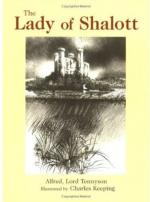|
This section contains 2,206 words (approx. 6 pages at 400 words per page) |

|
One of the most significant ways in which "The Lady of Shalott" manifests its politically selfdivided stance toward the values of patriarchal ideology colluding with and critiquing them at onceis by means of what might be called a discourse of the gaze. For patriarchy the difference between "masculine" and "feminine" sexuality is articulated in terms of a difference between activity and passivity. These differences are in turn rehearsed at the scopic level where the gazethe act of lookingis identified with a "masculine" (rather than "necessarily male") subject-position while women come, as the silent and passive objects of the gaze (and the "masculine" desire of which it is the sign), to occupy the site of the "feminine" and are as such denied the possibility of experiencing themselves as actively desiring subjects.
Tennyson's poem begins its reflections on the gaze and the question of sexual power-relations...
|
This section contains 2,206 words (approx. 6 pages at 400 words per page) |

|




